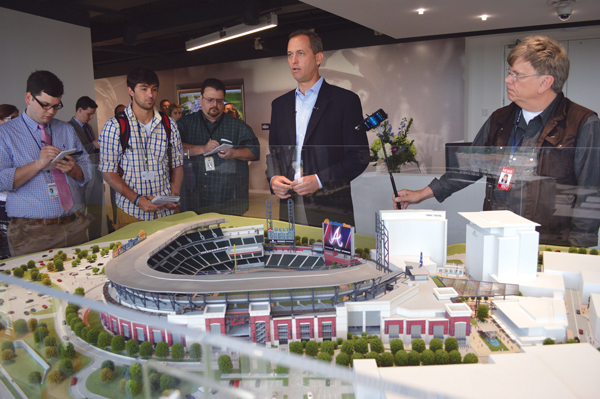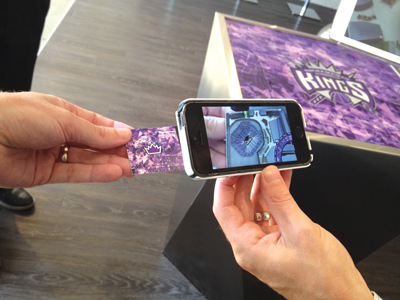 |
The Atlanta Braves’ Derek Schiller opens the SunTrust Park preview center, what he calls the team’s “most effective sales tool,” in September 2015.
Photo by: COBB CHAMBER
|
Clemson University’s $63.5 million renovation of Littlejohn Coliseum, completed this past fall, brought a modern update to the nearly 50-year-old facility, including a reworked exterior; new weight, locker and film rooms; and new offices for both the men’s and women’s basketball programs.
But the project initially wasn’t all good news for the school. The Littlejohn seating bowl, rotated 90 degrees from its prior configuration and reduced in capacity by 15 percent to about 8,500 seats, created some headaches for the Clemson athletic department as it sought to migrate its season-ticket base to the new arena layout.
Even though Clemson’s arena project was a renovation instead of an entirely new facility, the extensive changes made it almost impossible to have direct comparison in seat quality between the prior layout and the current one.
“There were a lot of difficult conversations early on,” said Owen Godfrey, Clemson assistant athletic director for ticket operations and sales. “Once people got inside the new building, it definitely got better, but it was certainly a process we went through. … We had a good bit of movement around the building by our fans. Some were disappointed, but for others, it was an opportunity to move into a better location.”
Clemson’s story, one also seen in dozens of other new and renovated facilities in pro and college markets such as Atlanta, Detroit, Sacramento and Minneapolis, highlights the high stakes involved in a seat relocation process. In each instance, the team or college athletic department is seeking to protect the season-ticket and donor bases that are its economic lifeblood. The process is also often where many of the new premium seats that are core to most facility projects and their financial models are sold.
But the seat relocation process is quickly becoming one of the most sophisticated and technology-dependent parts of sports ticketing, leaving essentially nothing to chance. Blending art and science, the efforts involve a variety of tools including focus groups, surveys, one-to-one salesmanship, multimillion-dollar sales centers, high-end computer imagery, and newer technologies such as virtual and augmented reality.
“We spent a great deal of time, the better part of two years really, getting ready for the transition, because we didn’t want to be reactive,” said Sacramento Kings President Chris Granger of the club’s move last year from Sleep Train Arena to the new Golden 1 Center.
“So that was a lot of surveying, meeting with fans, thinking through and analyzing pricing trends over multiple years, looking at other building openings and what they did, and so forth. We put a great deal of work into this at the front end, since the seat relocation obviously was a critical part of the whole process,” Granger said.
Setting priorities
The Atlanta Braves similarly started their seat relocation process 20 months ago in preparation for this spring’s opening of SunTrust Park in Cobb County, Ga. And one of the key questions facing the Braves, and most other teams in their type of situation, was which factors to prioritize in that effort.
Should the club focus its efforts on its longest-tenured season-ticket holders, and allow them first access to choosing their new seats, and does that data go back to prior ownership eras? Or should the process be strictly location-based, starting with fans holding the closest seats in the facility and proceeding toward the upper deck? Or should it be financially driven, starting with premium-level seating and then moving to the cheap seats?
College athletic programs that typically blend ticket sales with larger donor programs have additional factors to consider, and often have point systems to help prioritize season-ticket holders.
“The answer is going to be different for every team,” said Derek Schiller, Braves president of business. “For us, we have accurate ticket data going back 10 or 15 years, but it’s a little difficult before that to have good information on fans’ tenure with the club. So we ended up with a bit of a hybrid approach where location in the bowl was the top factor and we brought people in to our sales center in waves to select new seats.”
"This really is about what the team wants, but if the single goal is to maximize revenue, you’re making a big mistake. The top goal, however you approach it, should be getting your best fans closest to the action.”
CHRIS ALLPHIN,
VAN WAGNER SPORTS
AND ENTERTAINMENT
The club also involved Van Wagner Sports and Entertainment to assist its internal sales team. The consultants advised the Braves, as they do their other clients, to avoid making seat relocation efforts strictly a revenue-oriented process.
“This really is about what the team wants, but if the single goal is to maximize revenue, you’re making a big mistake,” said Chris Allphin, senior vice president for Van Wagner, which also aided the Minnesota Vikings migrating fans to the new U.S. Bank Stadium. “The top goal, however you approach it, should be getting your best fans closest to the action. There’s a real need in my mind to focus on the lower bowl game experience. And particularly where everything in this business is really about winning games, a relocation like this provides a big opportunity to maximize your home-field advantage.”
Maximizing that home-field advantage typically begins at a sales or preview center where a team can outline its vision for the new or renovated facility in full detail. Frequently, those sales centers are adjacent to the new facility construction or renovation site and overlook the work. And there, the ticket sales process often requires moving fans off their preconceived notions.
Ultimately, the Braves’ preview center became what Schiller called their “most effective sales tool,” with the facility also being rented out occasionally for private functions.
“A typical buyer comes in simply wanting their same location, and if that’s what they really want, you certainly give that to them,” Allphin said. “But usually, they also don’t understand all that the new building has to offer and that’s the chance to outline that to them. And in a case like the Braves, we saw a lot of movement around the facility after we explained everything SunTrust Park had to offer.”
Technology matters
The seat relocation process also has been a key beneficiary of the recent explosion in high-end digital imaging that includes both static and “fly-through” renderings, virtual reality and augmented reality. Tools such as these are increasingly being used to help fans visualize their seat views at the new or renovated facility, and experience something much more immersive than a two-dimensional rendering to aid in their ticket-buying decision.
Comcast Spectacor in late 2015 acquired Ballena Technologies and integrated the company’s three-dimensional imaging products and seat relocation management system into Spectra Ticketing & Fan Engagement. The technology has proved particularly useful for collegiate programs that do not have the budget to develop and staff a multimillion-dollar preview center like their professional counterparts.
 |
Sacramento used augmented reality to create 3-D images of Golden 1 Center’s seating chart.
Photo by: DON MURET / STAFF
|
“These types of technologies can really streamline the process,” said Kim Damron, Spectra Ticketing & Fan Engagement chief operating officer. “By putting these types of technologies in fans’ hands, you don’t necessarily have to see every season-ticket holder individually. They can see for themselves what their view and their experience is going to be like. And when you’re already spending millions on a renovation, it can be a real cost saver for the team.”
Spectra is now working on infusing virtual reality into the Ballena-powered products.
The Sacramento Kings, who frequently have been an early adopter of emerging technology, used products such as Oculus Rift-powered virtual reality and augmented reality enabled by London-based Inition to aid in their seat relocation process.
“There were a couple of important principles at play for us,” Granger said. “Since the Golden 1 Center is so different than Sleep Train Arena, we wanted every possible tool to help communicate what this new experience was going to be like. And technology was really key in making the relocation process easy for people. So the net result was that our fans really knew what they were getting in the new building.”
The Detroit Red Wings, opening Little Caesars Arena this fall, similarly have installed Oculus-powered virtual reality at the team’s 10,000-square-foot preview center within Comerica Park, as well as Virtual Venue imaging technology from Iomedia. The enhanced features have particularly aided the team in showcasing the new facility’s club spaces.
Allphin has a somewhat dissenting view on technology, believing that fans in many markets don’t often enjoy putting on virtual reality glasses or goggles in front of a group of onlookers. He still relies heavily on traditional sales tactics.
“Virtual reality is very cool, but I don’t find it drives decisions in a sales setting,” Allphin said. “The renderings are now so good. But in my mind, it still can’t compete with actually being at the site. In Atlanta, we did a lot of hardhat tours, particularly later on as the facility got closer to completion, and that was still very effective.”





